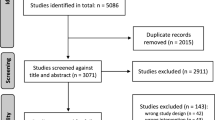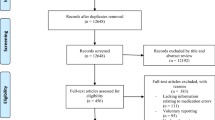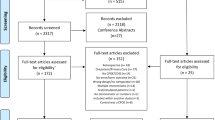Abstract
Introduction
The risk of dose errors is high in paediatric inpatient settings. Computerized provider order entry (CPOE) systems with clinical decision support (CDS) may assist in reducing the risk of dosing errors. Although a frequent type of medication error, the prevalence of dose errors is not well described. Dosing error rates in hospitals with or without CPOE have not been compared.
Objective
Our aim was to conduct a systematic review assessing the prevalence and impact of dose errors in paediatric wards with and without CPOE and/or CDS.
Methods
We systematically searched five databases to identify studies published between January 2000 and December 2017 that assessed dose error rates by medication chart audit or direct observation.
Results
We identified 39 studies, nine of which involved paediatric wards using CPOE with or without CDS. Studies of paediatric wards using paper medication charts reported approximately 8–25% of patients experiencing a dose error, and approximately 2–6% of medication orders and approximately 3–8% of dose administrations contained a dose error, with estimates varying by ward type. The nine studies of paediatric wards using CPOE reported approximately 22% of patients experiencing a dose error, and approximately 1–6% of medication orders and approximately 3–8% of dose administrations contained a dose error. Few studies provided data for individual wards. The severity and prevalence of harm associated with dose errors was rarely assessed and showed inconsistent results.
Conclusions
Dose errors occur in approximately 1 in 20 medication orders. Hospitals using CPOE with or without CDS had a lower rate of dose errors compared with those using paper charts. However, few pre/post studies have been conducted and none reported a significant reduction in dose error rates associated with the introduction of CPOE. Future research employing controlled designs is needed to determine the true impact of CPOE on dosing errors among children, and any associated patient harm.

Similar content being viewed by others
References
Ivanovska V, Rademaker CMA, van Dijk L, Mantel-Teeuwisse AK. Pediatric drug formulations: a review of challenges and progress. Pediatrics. 2014;134(2):361.
Corny J, Lebel D, Bailey B, Bussières J-F. Unlicensed and off-label drug use in children before and after pediatric governmental initiatives. J Pediatr Pharmacol Ther. 2015;20(4):316–28.
Koren G, Barzilay Z, Greenwald M. Tenfold errors in administration of drug doses: a neglected iatrogenic disease in pediatrics. Pediatrics. 1986;77(6):848–9.
Ghaleb MA, Barber N, Franklin BD, Yeung VWS, Khaki ZF, Wong ICK. Systematic review of medication errors in pediatric patients. Ann Pharmacother. 2006;40(10):1766–76.
Koumpagioti D, Varounis C, Kletsiou E, Nteli C, Matziou V. Evaluation of the medication process in pediatric patients: a meta-analysis. J Pediatr. 2014;90(4):344–55.
Miller MR, Robinson KA, Lubomski LH, Rinke ML, Pronovost PJ. Medication errors in paediatric care: a systematic review of epidemiology and an evaluation of evidence supporting reduction strategy recommendations. Qual Saf Health Care. 2007;16(2):116–26.
Sharek PJ, Classen D. The incidence of adverse events and medical error in pediatrics. Pediatr Clin N Am. 2006;53(6):1067–77.
Sullivan JE, Buchino JJ. Medication errors in pediatrics: the octopus evading defeat. J Surg Oncol. 2004;88(3):182–8.
Wong IC, Ghaleb MA, Franklin BD, Barber N. Incidence and nature of dosing errors in paediatric medications: a systematic review. Drug Saf. 2004;27(9):661–70.
Conroy S, Sweis D, Planner C, Yeung V, Collier J, Haines L, et al. Interventions to reduce dosing errors in children: a systematic review of the literature. Drug Saf. 2007;30(12):1111–25.
Garfield S, Reynolds M, Dermont L, Franklin BD. Measuring the severity of prescribing errors: a systematic review. Drug Saf. 2013;36(12):1151–7.
Maaskant JM, Vermeulen H, Apampa B, Fernando B, Ghaleb MA, Neubert A, et al. Interventions for reducing medication errors in children in hospital. Cochrane Database Syst Rev. 2015;3:CD006208.
Lehmann CU. Council on clinical information technology. Pediatric aspects of inpatient health information technology systems. Pediatrics. 2015;135(3):e756–68.
Bannan DF, Tully MP. Bundle interventions used to reduce prescribing and administration errors in hospitalized children: a systematic review. J Clin Pharm Ther. 2016;41(3):246–55.
Rinke ML, Bundy DG, Velasquez CA, Rao S, Zerhouni Y, Lobner K, et al. Interventions to reduce pediatric medication errors: a systematic review. Pediatrics. 2014;134(2):338–60.
Meyer-Massetti C, Cheng CM, Schwappach DL, Paulsen L, Ide B, Meier CR, et al. Systematic review of medication safety assessment methods. Am J Health Syst Pharm. 2011;68(3):227–40.
Franklin BD, Birch S, Savage I, Wong I, Woloshynowych M, Jacklin A, et al. Methodological variability in detecting prescribing errors and consequences for the evaluation of interventions. Pharmacoepidemiol Drug Saf. 2009;18(11):992–9.
Westbrook JI, Li L, Lehnbom EC, Baysari MT, Braithwaite J, Burke R, et al. What are incident reports telling us? A comparative study at two Australian hospitals of medication errors identified at audit, detected by staff and reported to an incident system. Int J Qual Health Care. 2015;27(1):1–9.
Wells GA, Shea B, O’Connell D, Peterson J, Welch V, Losos M. The Newcastle–Ottawa Scale (NOS) for assessing the quality if nonrandomized studies in meta-analyses. 2017. http://www.ohri.ca/programs/clinical_epidemiology/oxford.asp. Accessed June 2018.
Critical Appraisal Skills Programme. CASP cohort study checklist. 2017. http://www.casp-uk.net/casp-tools-checklists. Accessed June 2018.
Al-Jeraisy MI, Alanazi MQ, Abolfotouh MA. Medication prescribing errors in a pediatric inpatient tertiary care setting in Saudi Arabia. BMC Res Notes. 2011;4:294.
Al-Ramahi R, Hmedat B, Alnjajrah E, Manasrah I, Radwan I, Alkhatib M. Medication dosing errors and associated factors in hospitalized pediatric patients from the south area of the west bank – Palestine. Saudi Pharm J. 2017;25(6):857–60.
Campino A, Lopez-Herrera MC, Lopez-De-Heredia I, Valls-I-Soler A. Medication errors in a neonatal intensive care unit. Influence of observation on the error rate. Acta Paediatr. 2008;97(11):1591–4.
Campino A, Lopez-Herrera MC, Lopez-De-Heredia I, Valls-I-Soler A. Educational strategy to reduce medication errors in a neonatal intensive care unit. Acta Paediatr. 2009;98(5):782–5.
Davey AL, Britland A, Naylor RJ. Decreasing paediatric prescribing errors in a district general hospital. Qual Saf Health Care. 2008;17(2):146–9.
Dedefo MG, Mitike AH, Angamo MT. Incidence and determinants of medication errors and adverse drug events among hospitalized children in West Ethiopia. BMC Pediatr. 2016;16:81.
Dharmar M, Kuppermann N, Romano PS, Yang NH, Nesbitt TS, Phan J, et al. Telemedicine consultations and medication errors in rural emergency departments. Pediatrics. 2013;132(6):1090–7.
Feleke Y, Girma B. Medication administration errors involving paediatric in-patients in a hospital in Ethiopia. Trop J Pharm Res. 2010;9(4):401–7.
Fortescue EB, Kaushal R, Landrigan CP, McKenna KJ, Clapp MD, Federico F, et al. Prioritizing strategies for preventing medication errors and adverse drug events in pediatric inpatients. Pediatrics. 2003;111(4 Pt 1):722–9.
Ghaleb MA, Barber N, Franklin BD, Wong ICK. The incidence and nature of prescribing and medication administration errors in paediatric inpatients. Arch Dis Child. 2010;95(2):113–8.
Glanzmann C, Frey B, Meier CR, Vonbach P. Analysis of medication prescribing errors in critically ill children. Eur J Pediatr. 2015;174(10):1347–55.
Horri J, Cransac A, Quantin C, Abrahamowicz M, Ferdynus C, Sgro C, et al. Frequency of dosage prescribing medication errors associated with manual prescriptions for very preterm infants. J Clin Pharm Ther. 2014;39(6):637–41.
Jain S, Basu S, Parmar V. Medication errors in neonates admitted in intensive care unit and emergency department. Indian J of Med Sci. 2009;63(4):145–51.
Kaushal R, Bates DW, Landrigan C, McKenna KJ, Clapp MD, Federico F, et al. Medication errors and adverse drug events in pediatric inpatients. J Am Med Assoc. 2001;285(16):2114–20.
Kozer E, Scolnik D, Macpherson A, Keays T, Kevin Shi C, Tracy Luk C, et al. Variables associated with medication errors in pediatric emergency medicine. Pediatrics. 2002;110(4):737–42.
Lepee C, Klaber RE, Benn J, Fletcher PJ, Cortoos PJ, Jacklin A, et al. The use of a consultant-led ward round checklist to improve paediatric prescribing: an interrupted time series study. Eur J Pediatr. 2012;171(8):1239–45.
Machado APC, Tomich CSF, Osme SF, Ferreira DMLM, Mendonça MAO, Pinto RMC, et al. Prescribing errors in a Brazilian neonatal intensive care unit. Cadernos de Saude Publica. 2015;31(12):2610–20.
Martinez-Anton A, Ignacio Sanchez J, Casanueva L. Impact of an intervention to reduce prescribing errors in a pediatric intensive care unit. Intensive Care Med. 2012;38(9):1532–8.
Nikhithasri P, Ramya M, Kishore P. Assessment of medication errors in pediatricinpatient department of a private hospital. Int J Curr Pharm Res. 2017;9(6):70–5.
Ozkan S, Kocaman G, Ozturk C. Effect of strategies for preventing medication administration errors in pediatric inpatients. Turk Pediatr Arsivi. 2013;48(4):299–302.
Ozkan S, Kocaman G, Ozturk C, Seren S. Frequency of pediatric medication administration errors and contributing factors. J Nurs Care Qual. 2011;26(2):136–43.
Pallás CR, De-La-Cruz J, Del-Moral MT, Lora D, Malalana MA. Improving the quality of medical prescriptions in neonatal units. Neonatology. 2008;93(4):251–6.
Palmero D, Di Paolo ER, Beauport L, Pannatier A, Tolsa JF. A bundle with a preformatted medical order sheet and an introductory course to reduce prescription errors in neonates. Eur J Pediatr. 2016;175(1):113–9.
Parihar M, Passi GR. Medical errors in pediatric practice. Indian Pediatr. 2008;45(7):586–9.
Potts AL, Barr FE, Gregory DF, Wright L, Patel NR. Computerized physician order entry and medication errors in a pediatric critical care unit. Pediatrics. 2004;113(1):59–63.
Prot S, Fontan JE, Alberti C, Bourdon O, Farnoux C, Macher MA, et al. Drug administration errors and their determinants in pediatric in-patients. Int J Qual Health Care. 2005;17(5):381–9.
Rashed AN, Neubert A, Tomlin S, Jackman J, Alhamdan H, AlShaikh A, et al. Epidemiology and potential associated risk factors of drug-related problems in hospitalised children in the United Kingdom and Saudi Arabia. Eur J Clin Pharmacol. 2012;68(12):1657–66.
Rashed AN, Wilton L, Lo CCH, Kwong BYS, Leung S, Wong ICK. Epidemiology and potential risk factors of drug-related problems in Hong Kong paediatric wards. Br J Clin Pharmacol. 2014;77(5):873–9.
Sard BE, Walsh KE, Doros G, Hannon M, Moschetti W, Bauchner H. Retrospective evaluation of a computerized physician order entry adaptation to prevent prescribing errors in a pediatric emergency department. Pediatrics. 2008;122(4):782–7.
Stultz JS, Porter K, Nahata MC. Sensitivity and specificity of dosing alerts for dosing errors among hospitalized pediatric patients. J Am Med Inform Assoc. 2014;21(e2):e219–25.
Taylor JA, Loan LA, Kamara J, Blackburn S, Whitney D. Medication administration variances before and after implementation of computerized physician order entry in a neonatal intensive care unit. Pediatrics. 2008;121(1):123–8.
Warrick C, Naik H, Avis S, Fletcher P, Franklin BD, Inwald D. A clinical information system reduces medication errors in paediatric intensive care. Intensive Care Med. 2011;37(4):691–4.
Zeleke A, Chanie T, Woldie M. Medication prescribing errors and associated factors at the pediatric wards of Dessie Referral Hospital, Northeast Ethiopia. Int Arch Med. 2014;7:18.
Rinke ML, Moon M, Clark JS, Mudd S, Miller MR. Prescribing errors in a pediatric emergency department. Pediatr Emerg Care. 2008;24(1):1–8.
Otero P, Leyton A, Mariani G, Cernadas JMC. Medication errors in pediatric inpatients: prevalence and results of a prevention program. Pediatrics. 2008;122(3):e737–43.
Mekory TM, Bahat H, Bar-Oz B, Tal O, Berkovitch M, Kozer E. The proportion of errors in medical prescriptions and their executions among hospitalized children before and during accreditation. Int J Qual Health Care. 2017;29(3):366–70.
Chua SS, Choo SM, Sulaiman CZ, Omar A, Thong MK. Effects of sharing information on drug administration errors in pediatric wards: a pre-post intervention study. Ther Clin Risk Manag. 2017;13:345–53.
Buckley MS, Erstad BL, Kopp BJ, Theodorou AA, Priestley G. Direct observation approach for detecting medication errors and adverse drug events in a pediatric intensive care unit. Pediatr Crit Care Med. 2007;8(2):145–52.
Chedoe I, Molendijk H, Hospes W, Van Den Heuvel ER, Taxis K. The effect of a multifaceted educational intervention on medication preparation and administration errors in neonatal intensive care. Arch Dis Child Fetal Neonatal Ed. 2012;97(6):F449–55.
Holdsworth MT, Fichtl RE, Raisch DW, Hewryk A, Behta M, Mendez-Rico E, et al. Impact of computerized prescriber order entry on the incidence of adverse drug events in pediatric inpatients. Pediatrics. 2007;120(5):1058–66.
Newby BD. Dedicated fax machine to increase scrutiny of medication orders for pediatric hospital inpatients. Can J Hosp Pharm. 2008;61(5):329–33.
Kozer E, Scolnik D, Jarvis AD, Koren G. The effect of detection approaches on the reported incidence of tenfold errors. Drug Saf. 2006;29(2):169–74.
Rinke ML, Zimmer KP, Lehmann CU, Colombani P, Dover G, Garger C, et al. Patient safety rounds in a pediatric tertiary care center. Jt Comm J Qual Patient Saf. 2008;34(1):5–12.
Taketomo CK, Hodding JH, Kraus DM. Pediatric dosage handbook. 17th ed. Hudson: Lexi-Comp, Inc; 2010.
Baysari MT, Hardie R-A, Lake R, Richardson L, McCullagh C, Gardo A, et al. Longitudinal study of user experiences of a CPOE system in a pediatric hospital. Int J Med Inform. 2018;109:5–14.
Abramson EL, Kaushal R. Computerized provider order entry and patient safety. Pediatr Clin N Am. 2012;59(6):1247–55.
Brigham and Women’s Hospital. Computerized prescriber order entry medication safety (CPOEMS): uncovering and learning from issues and errors. Silver Spring: US Food and Drug Administration; 2015. https://psnet.ahrq.gov/resources/resource/29442/computerized-prescriber-order-entry-medication-safety-cpoems-uncovering-and-learning-from-issues-and-errors.
Cresswell KM, Bates DW, Sheikh A. Ten key considerations for the successful implementation and adoption of large-scale health information technology. J Am Med Inform Assoc. 2013;20(e1):e9–13.
Author information
Authors and Affiliations
Corresponding author
Ethics declarations
Conflict of interest
Peter Gates, Sophie Meyerson, Melissa Baysari and Johanna Westbrook have no conflicts of interest that are directly relevant to the content of this study.
Funding
Funding from a National Health and Medical Research Council Partnership Grant (APP1094878) was used to assist with the preparation of this manuscript.
Electronic supplementary material
Below is the link to the electronic supplementary material.
Rights and permissions
About this article
Cite this article
Gates, P.J., Meyerson, S.A., Baysari, M.T. et al. The Prevalence of Dose Errors Among Paediatric Patients in Hospital Wards with and without Health Information Technology: A Systematic Review and Meta-Analysis. Drug Saf 42, 13–25 (2019). https://doi.org/10.1007/s40264-018-0715-6
Published:
Issue Date:
DOI: https://doi.org/10.1007/s40264-018-0715-6




